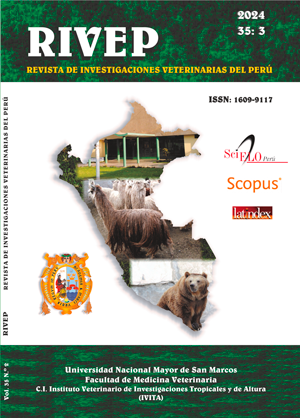Coelomitis due to obstructive egg dystocia in a common boa (Boa constrictor)
DOI:
https://doi.org/10.15381/rivep.v35i3.28272Keywords:
wild species, reptiles, oviparous, dystociaAbstract
The clinical case of an adult female Boa constrictor is described, with low body condition, dehydration, dysecdysis, and swelling at the cloacal level, with evident pain on palpation. Clinical examination and radiographic imaging confirmed the presence of a radiopaque oval structure in the last third next to the cloaca. The patient underwent exploratory laparotomy, where a yellow spheroid mass of approximately 8x4 cm and hard consistency was removed from the coelomic cavity, and a 4x4 cm fecaloma located in the colon. The patient died 6 days after surgery. At necropsy, the presence of three granulomas of 5x5, 3x2 and 2x1 cm between the oviducts was reported. In the microscopic findings, protozoan parasitic structures compatible with Cryptosporidium spp in the mesothelium and the vitellogenic follicle with several foci of bacteria were reported. The histopathological study determined severe coelomitis related to an obstructive dystocic process due to an egg.
Downloads
Downloads
Published
Issue
Section
License
Copyright (c) 2024 Karen Sofia Parrado Godoy, María Paula Cárdenas Velasco, María Clara Chacón García, Julieta Esperanza Ochoa Amaya, Pablo Felipe Cruz Ochoa, Dumar Alexander Jaramillo-Hernández

This work is licensed under a Creative Commons Attribution 4.0 International License.
AUTHORS RETAIN THEIR RIGHTS:
a. Authors retain their trade mark rights and patent, and also on any process or procedure described in the article.
b. Authors retain their right to share, copy, distribute, perform and publicly communicate their article (eg, to place their article in an institutional repository or publish it in a book), with an acknowledgment of its initial publication in the Revista de Investigaciones Veterinarias del Perú (RIVEP).
c. Authors retain theirs right to make a subsequent publication of their work, to use the article or any part thereof (eg a compilation of his papers, lecture notes, thesis, or a book), always indicating the source of publication (the originator of the work, journal, volume, number and date).










